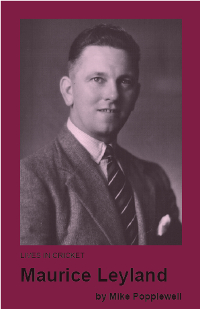Maurice Leyland
Martin Chandler |Published: 2017
Pages: 178
Author: Popplewell, Mike
Publisher: ACS
Rating: 3.5 stars

For some of us there is always a frisson of excitement to be felt when a new book emerges dealing with the life of one of the participants in the Bodyline series. So I begin this review of the story of Maurice Leyland with the news that there is nothing much to be seen here on that subject. That is hardly surprising after all that has already been written on the subject of the 1932/33 Ashes and is by no means a criticism of Mike Popplewell’s first contribution to the ACS Lives in Cricket series.
It must be tempting to dwell on that most famous of Test series but Popplewell plays it with the straightest of bats. Leyland played in all five Tests, and made two significant if not quite match winning contributions with the bat. The controversy and intrigue in the series, however, was not materially added to by Leyland, so the narrative rests on the series for just a handful of pages. It tells a couple of interesting stories about Leyland’s trip and produces another reminder of the sort of man the England captain was by reproducing a letter that Douglas Jardine wrote to Leyland’s wife during the trip, praising her husband’s qualities. It is very much in the manner of other correspondence he sent to the families of the professionals in his party.
Unlike many of the cricketers covered by this series Leyland was, on the field, a class act. He was a fixture in England’s middle order for the best part of a decade and averaged more than 46 in 41 Tests. Why, therefore, hasn’t he been the subject of a book before? In an interesting introduction Popplewell acknowledges that the reason is simply that Leyland was a very private person, who was well liked and steered a course through life that avoided attracting attention for anything other than his cricket. Spurred into researching Leyland by a friend, who had worked out in compiling her family tree that she was a distant relative of his, Popplewell ends his preliminaries by describing the fruits of his research as a tale that just had to be told. Is he right?
The answer to the question is probably yes, although the reader has to wait. The story is somewhat back to front in that it begins with the last Test of the 1938 series when, recalled after more than a year, Leyland played for England for the last time. As every cricket tragic knows England won that timeless Test by an innings and Len Hutton scored 364, in the course of which he added 382 with Leyland, whose contribution was 187.
Having begun with the end of Leyland’s career Popplewell goes back into traditional biographical territory by looking at Leyland’s family background and then following his career through the inter-war period. A freelance sportswriter for many years, the author is clearly aware of all the traps in that sort of approach. He is unable to turn Leyland’s story into a classic of the genre, but the bulk of the book might in other hands have been fairly tedious and much credit is due to Popplewell for that.
It is after Leyland’s playing career ended that the book becomes more compelling, and somewhat darker. There is no doubt that Leyland was a very private man, and journalists were less intrusive in those days but the post war resumption of his career with Yorkshire as a coach was no surprise. As time went on, however, ill health increasingly troubled Leyland. He suffered from Parkinson’s disease and although ground breaking surgery was of some assistance he still had to retire early. Other than an oblique reference to ill health and a suggestion that the cause was an old shoulder injury from his playing days he said little on the subject, and seems not to have been pressed. For a variety of reasons his last years were a sad decline, and thanks to the openness of those surviving friends and family members who gave much of their time to Popplewell, he is able to give a most thought-provoking insight of how life was for the disabled in 1960s Britain.
It is clear from the acknowledgments section at the end of the book that Maurice Leyland was a project that began more than a decade ago, and the long gestation period has no doubt contributed to the quality of the story being told. One of those who spoke to Popplewell years ago was Fred Trueman, one of those coached by Leyland, who I vividly recall when interviewed way back in the 1980s declaring that Wisden was wrong about Leyland, and that his Christian name was spelt ‘Morris’. It is slightly surprising that Popplewell doesn’t go into that as Fiery Fred was certainly correct insofar as Leyland’s birth certificate gave his name as Morris. Perhaps it was just a mistake on the part of the registrar as everywhere else, including on the 1911 census form completed by his father, it is Maurice.
This book is number 48 in the Lives in Cricket Series, and the first to not have a sub-title. That is a development about which I have no complaints; nor, on this occasion, does the additional bulk of the book trouble me – Leyland did, after all, play in as many as 41 Tests. The improvement, as the series has evolved, in the presentation of the books and the images within them is to be welcomed, but I do hope the lack of a statistical appendix, a bizarre omission in light of the publisher’s mission statement, is but a temporary aberration.







Leave a comment